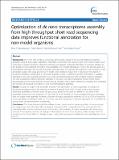Optimization of de novo transcriptome assembly from high-throughput short read sequencing data improves functional annotation for non-model organisms
Author(s)
Rismani-Yazdi, Hamid; Haznedaroglu, Berat Z.; Reeves, Darryl; Peccia, Jordan
DownloadHaznedaroglu-2012-Optimization of de novo transcriptome assembly from high-throughput short read sequencing data improves functional annotation for non-model organisms.pdf (1.643Mb)
PUBLISHER_CC
Publisher with Creative Commons License
Creative Commons Attribution
Terms of use
Metadata
Show full item recordAbstract
Background: The k-mer hash length is a key factor affecting the output of de novo transcriptome assembly packages using de Bruijn graph algorithms. Assemblies constructed with varying single k-mer choices might result in the loss of unique contiguous sequences (contigs) and relevant biological information. A common solution to this problem is the clustering of single k-mer assemblies. Even though annotation is one of the primary goals of a transcriptome assembly, the success of assembly strategies does not consider the impact of k-mer selection on the annotation output. This study provides an in-depth k-mer selection analysis that is focused on the degree of functional annotation achieved for a non-model organism where no reference genome information is available. Individual k-mers and clustered assemblies (CA) were considered using three representative software packages. Pair-wise comparison analyses (between individual k-mers and CAs) were produced to reveal missing Kyoto Encyclopedia of Genes and Genomes (KEGG) ortholog identifiers (KOIs), and to determine a strategy that maximizes the recovery of biological information in a de novo transcriptome assembly.
Results: Analyses of single k-mer assemblies resulted in the generation of various quantities of contigs and functional annotations within the selection window of k-mers (k-19 to k-63). For each k-mer in this window, generated assemblies contained certain unique contigs and KOIs that were not present in the other k-mer assemblies. Producing a non-redundant CA of k-mers 19 to 63 resulted in a more complete functional annotation than any single k-mer assembly. However, a fraction of unique annotations remained (~0.19 to 0.27% of total KOIs) in the assemblies of individual k-mers (k-19 to k-63) that were not present in the non-redundant CA. A workflow to recover these unique annotations is presented.
Conclusions: This study demonstrated that different k-mer choices result in various quantities of unique contigs per single k-mer assembly which affects biological information that is retrievable from the transcriptome. This undesirable effect can be minimized, but not eliminated, with clustering of multi-k assemblies with redundancy removal. The complete extraction of biological information in de novo transcriptomics studies requires both the production of a CA and efforts to identify unique contigs that are present in individual k-mer assemblies but not in the CA.
Date issued
2012-07Department
Massachusetts Institute of Technology. Department of Chemical EngineeringJournal
BMC Bioinformatics
Publisher
Biomed Central Ltd.
Citation
Haznedaroglu, Berat Z et al. “Optimization of De Novo Transcriptome Assembly from High-throughput Short Read Sequencing Data Improves Functional Annotation for Non-model Organisms.” BMC Bioinformatics 13.1 (2012): 170.
Version: Final published version
ISSN
1471-2105